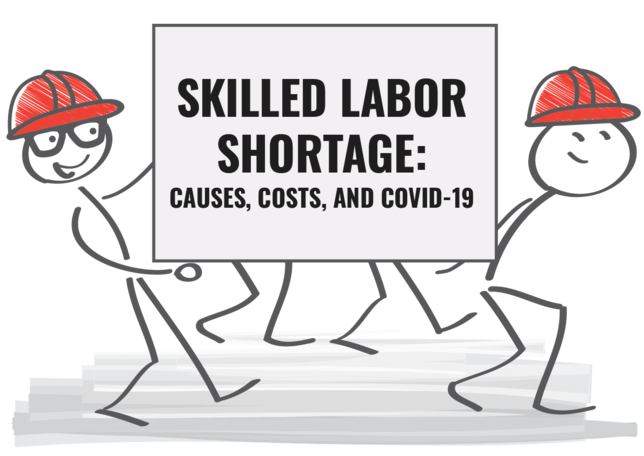Qualified job candidates are becoming harder and harder to find thanks to the skilled labor shortage.
Between the dropping unemployment rate, more job openings, increased consumer demand, heightened e-commerce expectations, and the COVID-19 pandemic, there aren’t just fewer candidates per job.
There are fewer qualified candidates per job.
This article will explain the reasons behind the lack of skilled workers, along with the effects of the shortage.
It’ll also cover the impact of the novel coronavirus, provide skilled labor shortage statistics, and outline strategies for recruiting skilled workers.
Let’s dive in.
What is Skilled Labor?
According to Investopedia:
“Skilled labor is a segment of the workforce that has specialized know-how, training, and experience to carry out more complex physical, or mental tasks than routine job functions. Skilled labor is generally characterized by higher education, expertise levels attained through training and experience, and will likewise correspond with higher wages.”
We’ll be focusing on skilled trades in this article, primarily those in the construction and manufacturing industries.
Some skilled positions in these industries include:
- Electricians
- Plumbers
- Carpenters
- Machinists
- Steelworkers
- Welders
- Pipefitters
The Causes of the Skilled Labor Shortage
Many factors have contributed to a shortage of skilled workers.
Let’s cover some of the major ones.
A Decline in Apprenticeship Programs
In the 1980s, many companies began focusing on ways to streamline their operations.
One strategy they used was eliminating any programs that didn’t contribute to a positive return on investment (ROI).
Consequently, apprenticeships were nixed.
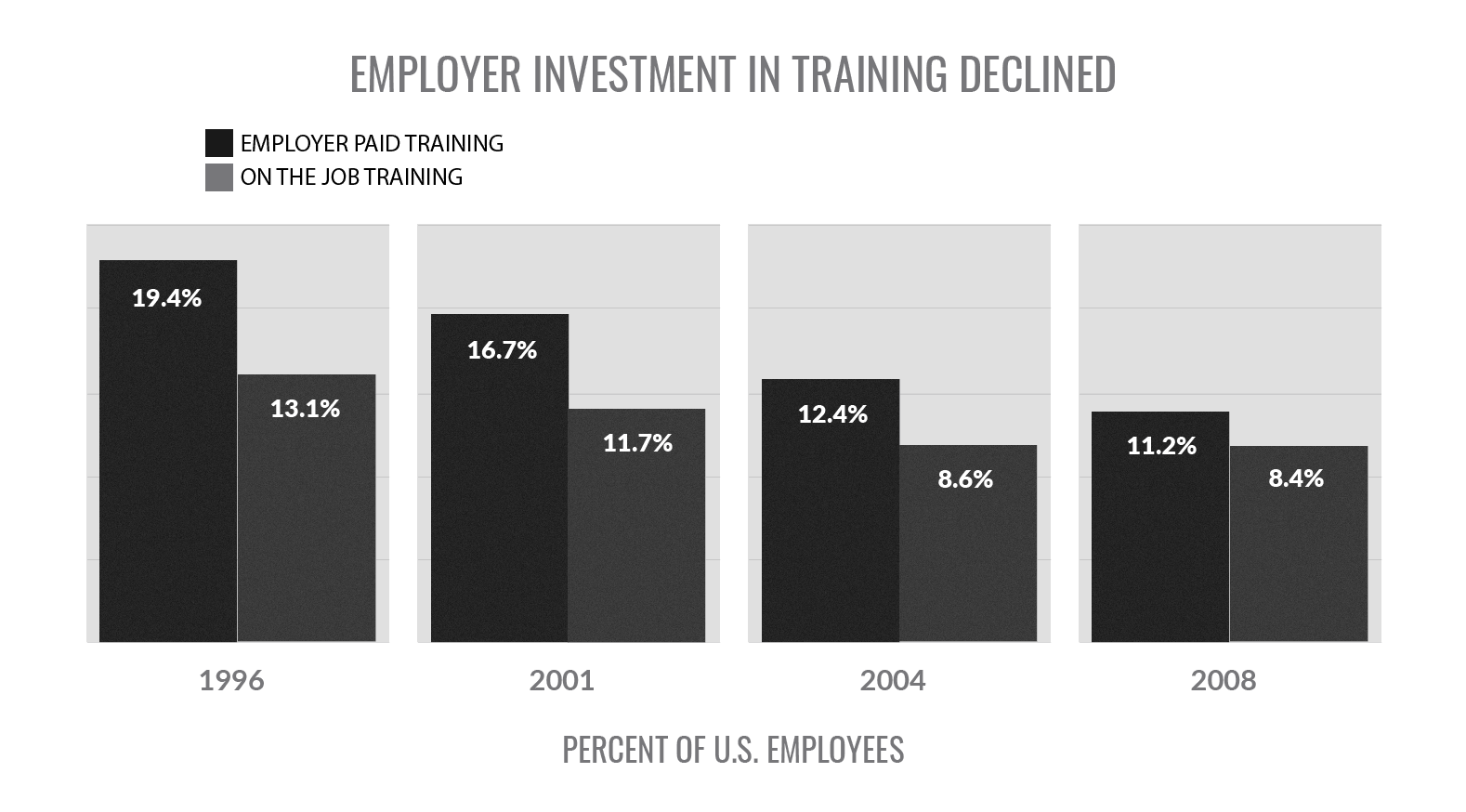
Fast forward to today, and the result has been a dramatic reduction in the number of apprentices in the workforce:
“… manufacturing employs about 12 million workers and is training 11,447 apprentices. Less than 1% of the total manufacturing workforce is getting formal advanced training in the form of apprenticeships.”
The Great Recession and Worker Exodus
When the last economic downturn happened in 2008, many skilled laborers – especially in construction – were laid off.
Instead of returning to what they perceived as an unstable industry, many either retired or began working in different industries.

According to Ken Simonson, chief economist for the Associated General Contractors, 2.3 million construction jobs disappeared during the Great Recession and its aftermath.
But only 1.2 million jobs were added back.
Retiring Baby Boomers
According to Census.gov, 10,000 Baby Boomers reach age 65 every day.
And by 2030, all Baby Boomers will be at least age 65.
“…the Boomer labor force has been declining by 2.2 million on average each year since 2010, or about 5,900 daily.”
Retirement itself isn’t the issue, per se.
It’s more so that Baby Boomers aren’t being replaced by enough younger workers.

The result isn’t only a labor shortage.
It’s also creating a gap in knowledge, as Baby Boomers are taking their extensive experience and knowledge with them instead of passing it on.
Elimination of Shop Class
In decades past shop class was a popular option in middle and high schools.

According to Dan Taddei, director of education and certification for the National Association of the Remodeling Industry, these classes were one of the primary gateways for students to get exposure to jobs in the skilled trades.
But this “pipeline” that existed to feed students into those jobs dried up in the early 2000s.
Mr. Taddei notes that one of the reasons for this was the passage of the No Child Left Behind Act in 2002.
The Act forced schools to spend more time on reading and mathematics, with a special focus on preparing kids for college.
“The message became that you need to have a college degree or you’re a lesser individual,” he says. “We aren’t exposing people to these opportunities, and the funding model in public schools supports college-or-bust.”
But it also meant schools spent less time on other subjects – including shop class.
The result has been that fewer students in the last two decades have gotten exposure to career opportunities in the skilled trades.
Less Enthusiasm for Skilled Work
Put simply, the younger generations – Millennials and Gen Z – tend to have a negative view of skilled labor.
Many see these jobs as dirty, dangerous, and overly physical.
And they’d rather do work that’s more technology-focused than physically-demanding.

But it isn’t just students who hold these false views either.
Parents, and even educators, view skilled work as a fall-back career – something undesirable for their kids to consider.
And so they often push white-collar jobs instead, furthering the shortage of skilled workers.
Less Interest in Taking Over the Family Business
Many construction, manufacturing, plumbing, electrical, HVAC, and other skilled labor businesses are family-owned.
But the trend in recent years is for children of owners to explore their career options, outside of the family business.
In fact, a 2017 survey conducted by PricewaterhouseCooper found that only 52% of family business owners who intend to give up their business in the next five years expect to pass their company on to other family members.

This figure was down from nearly 74% two years previously.
And without passing on their knowledge to the next generation, the skilled labor market suffers further from a supply shortage.
The Effects of the Skilled Labor Shortage
The skilled labor shortage has caused a rippling effect across the entire world.
Here’s how the effects have been felt.
Lower Morale
Since there are fewer workers to do the work, existing employees have had to pick up the slack.
That has meant longer hours and less time off.
For some workers, the boost in pay has been a welcomed bonus.
They’ve been able to enjoy a higher standard of living and pay off debts.
But for others, the result has been burnout, frustration, and defection.

According to a 2019 survey by Deloitte, 91% of workers reported that burnout has affected both their work and personal relationships.
And for the economy as a whole, the cost of employee burnout is estimated to be between $125 and $190 billion, between productivity losses and healthcare costs.
Higher Wages
Both to retain workers and attract more to their companies, employers have been raising wages and improving benefits.
“38 percent of firms report having increased base pay rates to attract and retain workers.”
Lower Hiring Standards
With fewer applicants to choose from, employers have had to hire less qualified candidates.
With less qualified employees comes poorer work, higher costs, less satisfied customers, and inevitably lower revenues.
Not to mention the impact on workplace safety:
“…the U.S. Bureau of Labor and Statistics data shows that 34.9% of new, untrained workers in the construction industry are injured during their first year on the job.”
Higher Training Costs
Hiring less-skilled workers has required more training to get them up to speed.
And of course, more training costs more money.

Plus, with many job opportunities for workers, the temptation exists to jump ship for a better offer.
When that happens, employers must absorb the costs of training and lower productivity without reaping any rewards.
In effect, many employers are training employees for their competitors.
Lower Revenues
Companies simply can’t do as much with fewer workers to get the job done.
To cope, they’ve had to increase lead times and turn down work when they cannot meet the demand.
This has resulted in fewer satisfied customers, along with lower revenues.

Here are some statistics that highlight just how much money is being left on the table as a result of the skilled worker shortage:
- The heavy equipment industry is losing more than $2.4 billion every year because dealerships can’t hire enough skilled workers
- Globally, the manufacturing labor shortage is expected to be 8 million people by 2030, with a potential revenue loss of $607 billion
More Expensive Products
With higher wages and lower revenues, companies have been forced to raise their prices for the same work.
In the construction industry alone, there was a 5.8% increase in costs in 2018 according to Forbes, which is thought to be the result of the labor shortage.
COVID-19 & Skilled Labor
As we’ve discussed, many of the root causes of the skilled labor shortage have been years in the making.
But the COVID-19 pandemic has exacerbated some of the problems while alleviating others.
Companies have been forced to consider new strategies to stay afloat – painful as some may be.
“Firms have imposed a number of special measures to limit the negative financial impact of Covid-19 on their firms, including freezing hiring and terminating and furloughing employees.”
Let’s explore some of the ways that the coronavirus has impacted industry as a whole.
Supply and Demand
According to Trevor Smith, business services representative for PA CareerLink, the pandemic has increased the demand for items like personal protective equipment (PPE), masks, and sanitizer.
The result has been more skilled workers have the opportunity to work.
But it’s not all good news.

Many workers are hesitant to expose themselves to the virus
Others must stay home to take care of dependents.
And still, others have made more money from unemployment than they would have from working.
So while there has been more demand for workers, the problem is still the same as before the pandemic: Fewer workers willing and able to do the work.
Slower Production
With companies already struggling to meet demand due to the labor shortage, the coronavirus is digging them into a deeper pit.
Not only can’t they find skilled workers, but many of those they can find are either unable or unwilling to return to work.
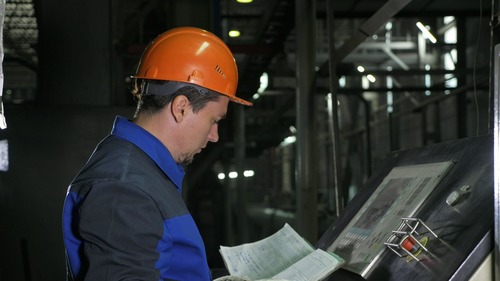
The result?
Per the U.S. Chamber of Commerce, 71% of contractors are struggling to meet their scheduling commitments.
And 39% of contractors have had to turn down work.
Less Money
Many local and state governments are experiencing budgetary shortfalls, as a direct result of the pandemic.
“…state and local government revenues will decline $155 billion in 2020, $167 billion in 2021 and $145 billion in 2022.”
This has caused a reduction in financing for infrastructure projects.
And since many contractors rely on government-funded projects to stay in business, they’ve taken a direct financial hit.
Thus, the challenge is two-fold: Fewer skilled workers to work, and less money to fund the work – and their skilled employees – in the first place.
Spotlight: Construction, Manufacturing, and The Pandemic
The manufacturing and construction industries specifically have been affected greatly by the COVID-19 pandemic.
Let’s detail some of the particular problems these industries are facing.
Construction
The construction industry as a whole has lost $60.9 billion in gross domestic product (GDP).
Furthermore, they’re experiencing a shortfall of 6.5 million jobs due to the pandemic.
IBISWorld reports that “[i]ndustry revenue is expected to decline 6.3% in 2020 as a result of the COVID-19 (coronavirus) pandemic.”
And the Associated General Contractors of America (AGC) notes that “roughly a third of responding [construction] firms furloughed or terminated employees as a result of the pandemic and shutdowns ordered.”
Additionally, the AGC reports that:
- 28% of construction firms are having difficulty finding project managers and supervisors
- 52% of companies are struggling to fill openings for laborers, carpenters, and equipment operators
- 73% of highway and transportation contractors, 69% of utility infrastructure and federal and heavy construction firms, and 58% of building construction firms have unfilled craft positions as of June 30, 2020
Manufacturing
PricewaterhouseCooper recently surveyed industrial manufacturers to find out their top business concerns in light of COVID-19.
Forty-one percent reported that the effects of the pandemic on their work forces and the resulting reduction in productivity were among their top three worries.
And the financial picture isn’t pretty either.
According to RSM’s Middle Market Business Index survey, 71% of manufacturers reported that they’d lost revenue between April 8 and April 23 due to the pandemic.
Overall, Deloitte reports that “…the skills gap [in the manufacturing sector] may leave an estimated 2.4 million positions unfilled between 2018 and 2028, with a potential economic impact of 2.5 trillion.”
Bridging the Skilled Labor Gap
To recruit more skilled workers, companies will need to get creative.
“The long-term effects of the current crisis have yet to play out, and firms that double down on innovation efforts, whether an increased focus on lean construction, workforce training or technology that facilitates remote collaboration will be well poised for enduring resilience.”
Allison Scott, director of construction thought leadership and customer marketing at Autodesk
The following are some of the most effective strategies for how to find skilled labor.
Combat False Perceptions of Skilled Work
As we’ve discussed, many younger people – along with their parents – have the perception that skilled work is a “fallback” career for those who can’t do anything else.
But the reality is very different.
Skilled labor positions offer excellent pay, benefits, and job security, along with terrific career paths for those who want to climb the ladder.

One organization that’s done well with changing perception is the Pennsylvania-based Manufacturers Resource Center (MRC).
Through partnerships with various educational institutes and local manufacturers, they created a program called “What’s So Cool About Manufacturing?”
In it, manufacturing companies partner with local school children to design and create videos that showcase the positives of working in the manufacturing industry.
Since its creation in 2013, the program has grown from 19 schools to 250 schools and spread to 11 other states.
And the results are encouraging.
Lehigh Career and Technical Institute (LCTI) – a partner school in the program – has managed to increase their science, technology, engineering, and math (STEM) enrollment by 50% since the program began!
You can learn more about the “What’s So Cool About Manufacturing?” program at https://www.whatssocool.org/.
Create Better Marketing
Changing perceptions among the younger generation of potential skilled workers requires that your marketing be on point and shown in the right places.
One way to do just that is by crafting your messaging to those younger folks for whom college isn’t the right fit.
Every year, about 1 million kids don’t go to college.
And, one-third of college students drop out before attaining a degree.
Beyond those factors, fewer students are eyeing college because of:
- Rising college tuition
- Crippling student loan debt
- Difficulty finding jobs in graduates’ field of education
Fortunately, recent surveys show that younger workers are coming around to skilled labor opportunities.
“One-third (32 percent) of Gen Z has had manufacturing suggested to them as a career option, as compared to only 18 percent of Millennials and 13 percent of the general population.”
These factors show that there’s plenty of potential in attracting younger workers to skilled labor positions over a 4-year college education.
But you have to market your message in the right way.
That means putting your message where younger folks are hanging out: Facebook, Twitter, Instagram, and the like.
But what exactly should you say in your marketing?

Marketing expert and president of BuildWitt Media Group Aaron Witt suggests telling the story of your company in a way that resonates with prospective employees.
That can include:
- Sharing topics of interest to prospective employees
- Demonstrating why skilled labor is exciting
- Explaining the significance of the work you do
- Showing what skilled labor can offer employees
- Featuring unique projects, interesting equipment, and innovative technologies used in the field
- Showing the satisfaction employees gain when completing a project
Another creative marketing strategy for reaching younger workers is harnessing cutting-edge technology.
Virtual reality (VR) headsets, like Facebook’s Oculus, have already shown promise in helping to train new workers safely and cost-effectively.
And this new technology can be easily transferred to recruitment efforts, too.
Via job fairs and career expos, companies can use VR to demonstrate to prospective employees what it’s like to work in the skilled trades.
General Mills, for example, has been using VR to give interested employees a preview of their headquarters and work environments.
Beyond the immediate benefits of improving recruitment efforts, using VR and other up-and-coming technologies shows younger workers that your company is technology-literate and “with the times.”
This can go a long way with Millenials and Gen Zer’s, who are technically proficient and expect firms to be up to speed with new technologies.
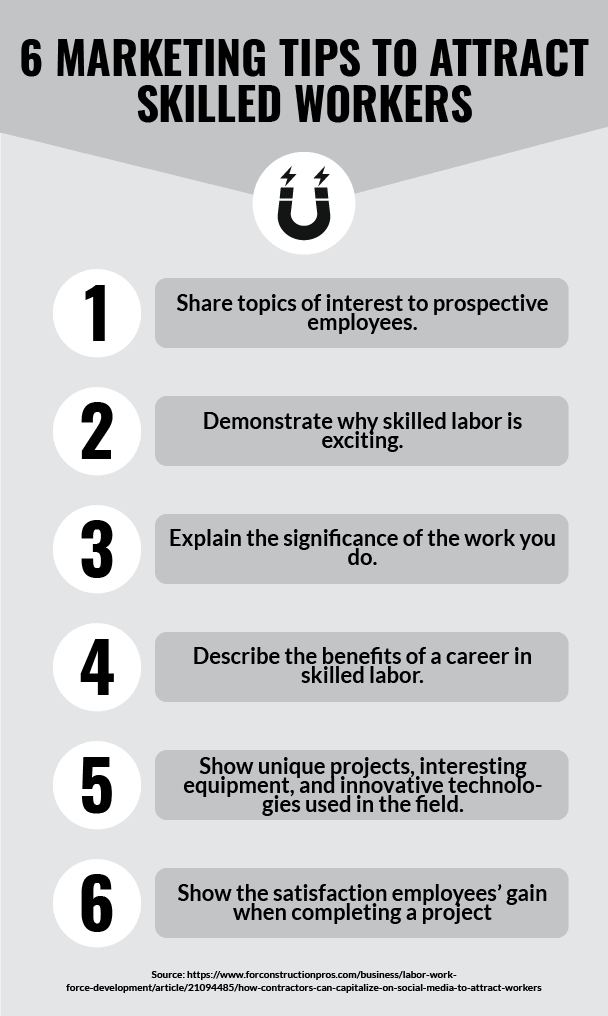
Keep Your Current Employees
As important as it is to recruit younger skilled workers, it’s equally important to keep your existing workforce satisfied.
While the COVID-19 pandemic has forced skilled industries to do more with less, the fact is that wages and benefits must be competitive.
Otherwise, employees may leave for better opportunities.
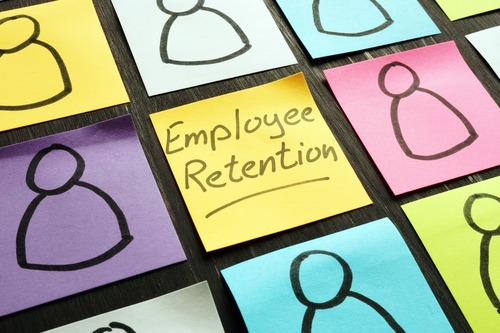
Besides compensation, it’s also critical to offer your employees pathways to future advancement.
While some workers may simply want a “job,” others aren’t satisfied with that.
They have their eyes’ on advancement and opportunity.
Besides compensation, it’s also critical to offer your employees pathways to future advancement.
While some workers may simply want a “job,” others aren’t satisfied with that.
They have their eyes’ on advancement and opportunity.
An effective way to provide this kind of advancement is by cross-training your employees, which we’ll cover below.
Train Your Current Employees
To sustain a skilled labor force, there’s no way around the fact that there must be investments in employees’ training and skill development.
Unfortunately, the United States as a whole lags in this regard.
The New York Times, using data from the Organization for Economic Cooperation and Development, reports that:
“The United States also spends less than other nations on government employment, training and other labor services. As a percentage of economic activity, Canada spends three times as much, Germany about six times more and Scandinavian countries up to more than 12 times as much…”
But companies must take the initiative to train their employees – instead of waiting for the government to do it.
Fortunately, online services learning programs like Coursera and Udacity can help train employees in new skills for little cost.
But there’s more to the business case for training your employees to develop new skills…

For one, they’ll be able to contribute more to your organization.
One company that benefited from cross-training in this regard is Exelon.
They predict being able to save $1 million over 8 years by retraining their employees to track equipment maintenance.
For another, you can improve productivity and efficiency by cross-training your employees to do other tasks.
Ci Metal, for instance, has done this with excellent results.
Instead of standing around waiting for something to do, their employees can take up new tasks on which they’ve received specialized training.
Furthermore, cross-training can help retain workers by giving them new career path options.
All in all, there’s a lot to be gained by training your existing employees to do more.
Team Up with Local Schools
Companies can reap a lot of value from partnering with local high schools and technical colleges to provide skilled labor training.
By increasing awareness of the existence and benefits of skilled work, students can discover opportunities that they may have never considered before.
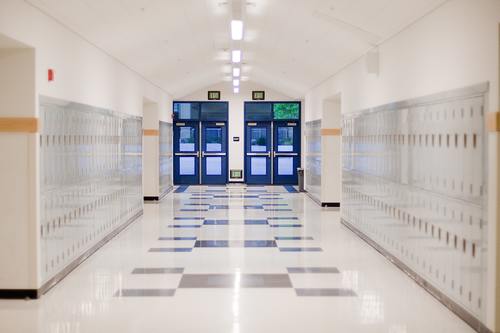
Conger Industries, for example, has had great success partnering with local high schools to recruit and teach students how to repair material handling equipment.
But companies can also go beyond simply recruiting students.
One strategy is to help schools develop skilled worker training programs, which can feed students into their industry.
One example of this strategy in action is the Gulf Coast Builders Exchange.
They created a “construction rodeo” to attract high school students to the construction industry:
“The daylong event attracts about 500 students, introducing them to the trades through hands-on activities, conversations with employees and opportunities for internships and apprenticeships…resulting in several internships and apprenticeships.”
All in all, local high schools and technical colleges offer excellent routes for students and companies to come together, helping to alleviate the skilled labor shortage in turn.
Hire More Veterans
One great pool of highly-qualified applicants for skilled trade positions is military veterans.
Unfortunately, veterans are underrepresented in the workplace:
“One-third of veterans are underemployed, or overqualified for their jobs, and 44 percent left their first post-military job within one year, citing a lack of purpose or inability to utilize their skills.”
Fortunately, companies can do much to help.
And they can recruit some excellent workers at the same time.

After all, veterans make perfect employees: They are disciplined and have an excellent work ethic. They’re also responsible, honest, and accountable.
One program that’s helping match veterans with employers of skilled labor is Helmets to Hard Hats.
As of 2019, the non-profit organization has helped place 30,000 veterans in the construction industry!
Hire More Women
Historically, women have been grossly underrepresented in the skilled labor market.
“29% of manufacturing jobs are held by females, just 4% of construction and trade labor jobs are currently being done by women.”
Some of the reasons for this under-representation are misogyny and sexism.
But those reasons simply don’t mesh with reality.
Because the truth is that women are just as capable of working in the skilled trades as men are.
In fact, hiring women comes with benefits that hiring men doesn’t always bring.

For instance, women offer unique workplace and market perspectives that male-dominated companies don’t.
For another, women tend to pay greater attention to detail and work with greater precision.
Furthermore, women tend to stay in their communities for the long term, lowering the costs of replacing and retraining workers.
Additionally, hiring more women can help enhance a company’s reputation as diverse and inclusive.
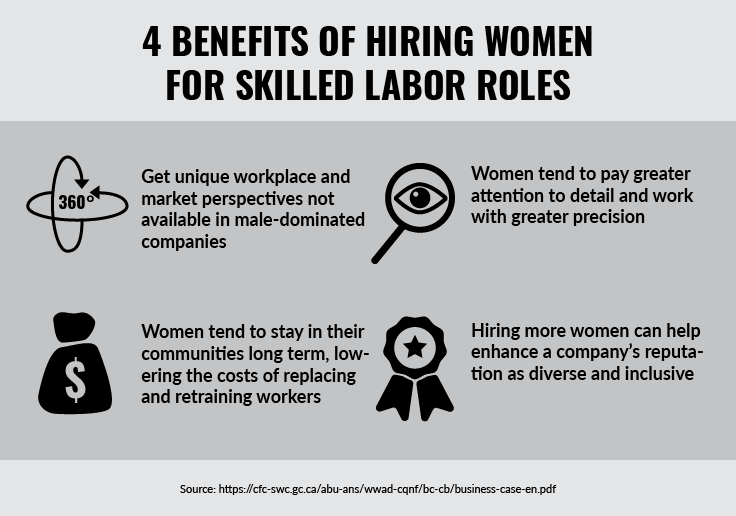
One example of a firm that’s had success hiring women for skilled labor roles is S&B Engineers and Constructors of Houston, Texas.
They developed the “Women’s Training Program” to train women to become pipefitters.
And the results have been encouraging:
“Sixteen of the 20 trainees completed the program. Only one of the 16 graduates has left S&B; however, she is working for another employer in the construction industry. All 16 graduates are continuing their enrollment in craft training with the intention of becoming a fully accredited, journey-level pipefitter. No loss in production was experienced during the implementation of the program.”
But you can’t expect to set up a program and get results instantly.
Because to hire more women, companies must get something right at the start: Addressing what it is that women in the workplace are looking for.
Gallup offers two clues of what that is:
“…the two most important workplace factors for women are the ability to do what they do best and work-life balance.”
If you craft a marketing message that highlights how your company does those two things effectively, you’ll stand a better chance of recruiting more women to fill the skilled labor gap.
Consider Employing Those with Criminal Records
Hiring ex-prisoners has long been a source of controversy and worry for employers and employees alike.
But with the shrinking labor pool, attitudes are beginning to change.
Not only can employers derive skilled labor from recently-released prisoners.
But prisoners themselves – and their communities – can benefit from quick employment.

Evidence from America Works’ prison-to-work programs shows that recidivism can drop as much as 95% when prisoners land jobs shortly after release.
One company that has benefited from hiring former prisoners is Chandler, AZ-based construction firm Erickson Cos.
They’ve hired nearly 30 ex-cons to aid in constructing frames for new homes.
And it was largely spurred by the need to cope with a scarce skilled labor pool.
“We’re searching for every alternative avenue that we possibly can to help solve this labor shortage.”
While the hesitancy to hire those with criminal records is understandable, the benefits to employers, communities, and prisoners alike may outweigh the risks.
Leverage Automated Solutions
Automation in the workplace has been a popular topic of conversation in the past several years.
The U.S. Bureau of Labor Statistics (BLS) notes the impact of automation in manufacturing:
“The manufacturing sector is projected to lose 444,800 jobs, the most of any sector over the projections decade… Factors contributing to the loss of manufacturing jobs include the adoption of new productivity-enhancing technologies, such as robotics and international competition.”
And while automation has taken off in manufacturing, replicating the same in the construction industry is a difficult task.
Since every construction project is unique, involves multiple specialist contractors, is subject to the weather and environment, and is complicated by constantly changing plans, the challenge is quite immense.
That said, robotics are still slowly making their way into construction.
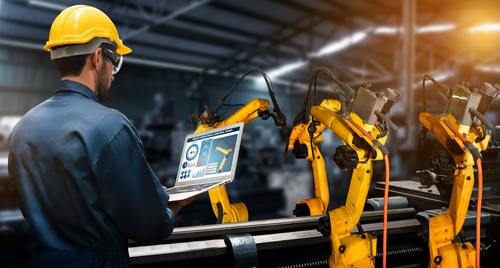
For example, Japan is currently experimenting with dam construction using autonomous systems, which has resulted in a 10% increase in productivity.
Automation is only expected to become more popular as the technology is fine-tuned and obstacles overcome:
“In the next three decades, as many as 2.7 million construction jobs could become automated, according to a report from the Midwest Economic Policy Institute. That could result in $30 billion in reduced labor costs in 2020 dollars…”

Conclusion
There you have it: The ins and outs of the skilled labor shortage…. And what you can do about it.
Now we’d like to turn it over to you.
Has your company struggled with skilled labor shortages?
What strategies have you tried to alleviate the problem?
And what were your results like?
Let us know in the comments below!
